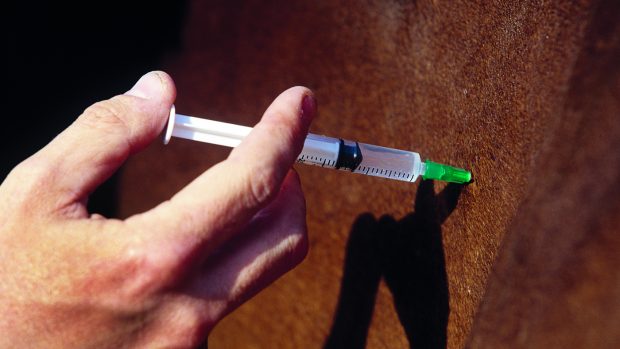Vets and horse owners have been put on the alert after more cases of equine herpes virus (EHV) paralytic disease have been identified in the south of England.
This is the rarest form of EHV, which usually results in respiratory disease in young horses, and abortion in pregnant mares. The recent outbreaks are unusual, as they involve mostly non-breeding and performance animals of both sexes.
The first two cases were at racehorsetrainer Nigel Twiston-Davies’s Gloucestershire yard and both horses were destroyed. The third, in a point-to-pointer in Sussex, was confirmed on 13 March, and this horse was also put down.
Probable cases in two Kent yards were reported around the same date. Two horses on a show jumping yard suffered relatively mild neurological signs, from which they are recovering, and, approximately 40 miles away, a large livery yard has tragically lost at least five horses to the infection.
“We are all very concerned,” says Jackie Cardwell, vet and epidemiologist at the Animal Health Trust’s Centre for Preventive Medicine. “But fortunately, this is not the kind of infection that will spread rapidly across the country like foot-and-mouth.”
Respiratory disease or a high temperature can preceed paralytic disease and horse owners are advised to keep their horse at home and call their vet signs of these illness are shown.
However, neurological signs can also appear out of the blue. Signs to look out for include a high temperature, dribbling urine and weakness or paralysis of the hindlimbs and tail.
The disease may progress rapidly, usually peaking by 48hr after onset, and the horse may go down and be unable to get up: if this happens, in many cases it is more humane to put the horse to sleep.
However, the outlook for an infected horse is not always bleak – many horses on an affected yard will become infected but not develop neurological disease. Others will show some signs but recover fully – and there is no evidence to suggest that once a horse has recovered, it is likely to spread the disease to others.
Unlike foot-and-mouth, this virus does not tend to travel long distances through the air. Infection is spread mainly by contact with infected horses. People can carry infection between horses by handling an infected animal and touching other horses, tack, equipment and so on.
Coping with an outbreak
If your yard becomes affected, the following steps are recommended to limit the spread of the virus both within it and to other premises:
1. The entire yard should be closed. No horses should be allowed off or on to the premises until 30 days after the last case has occurred or until the vet in charge is satisfied that there is no longer any risk.
2. It may be wise to segregate horses into groups, depending on the yard structure. These groups can then be managed separately. Get your vet’sadvice on the best way of segregating horses in a particular yard.
3. Monitor the temperatures of all horses on the yard twice daily. A temperature rise is often the first clinical sign of infection and often precedes neurological signs by two to eight days. Any horse showing a rise in temperature should be investigated further.
4. Disinfectant footbaths should be placed outside each stable and hands washed after handling each horse. Alternatively, disposable latex gloves can beworn and changed between horses.
5. All confirmed or suspect cases, including those with a temperature rise, must be treated as if in quarantine. People handling these horses should, if possible, not handle others. Protective clothing should be available for use when handling an infected horse.
6. Stables should be disinfected if the horse moves out. A disinfectant such as Virkon or steam cleaning will destroy the virus.
|
Read the full story in this week’s Horse & Hound (3 April), or click here to subscribe and enjoy Horse & Hound delivered to your door every week. |




